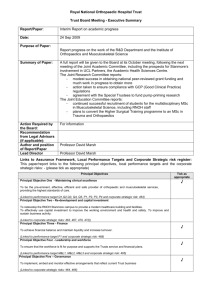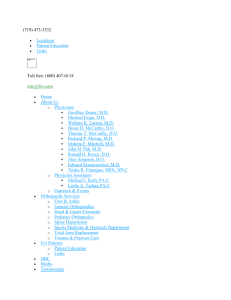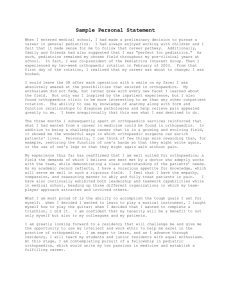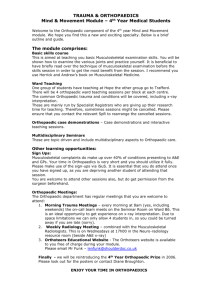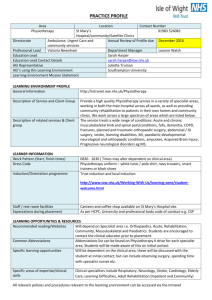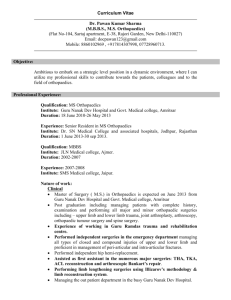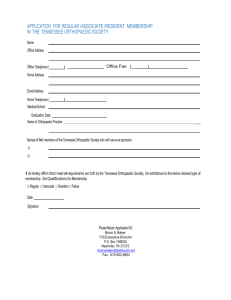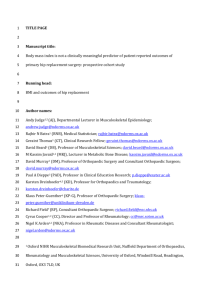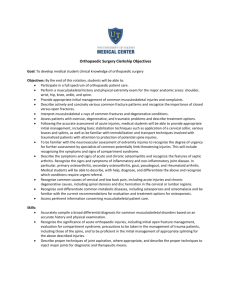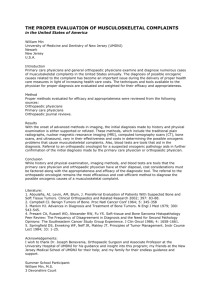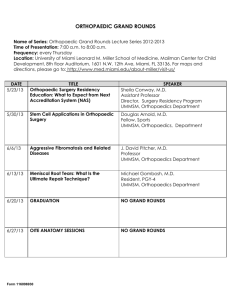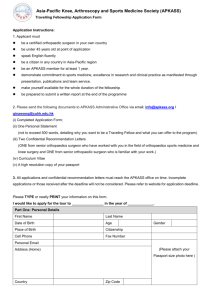Adult and Pediatric Orthopaedics and Traumatology with Elements
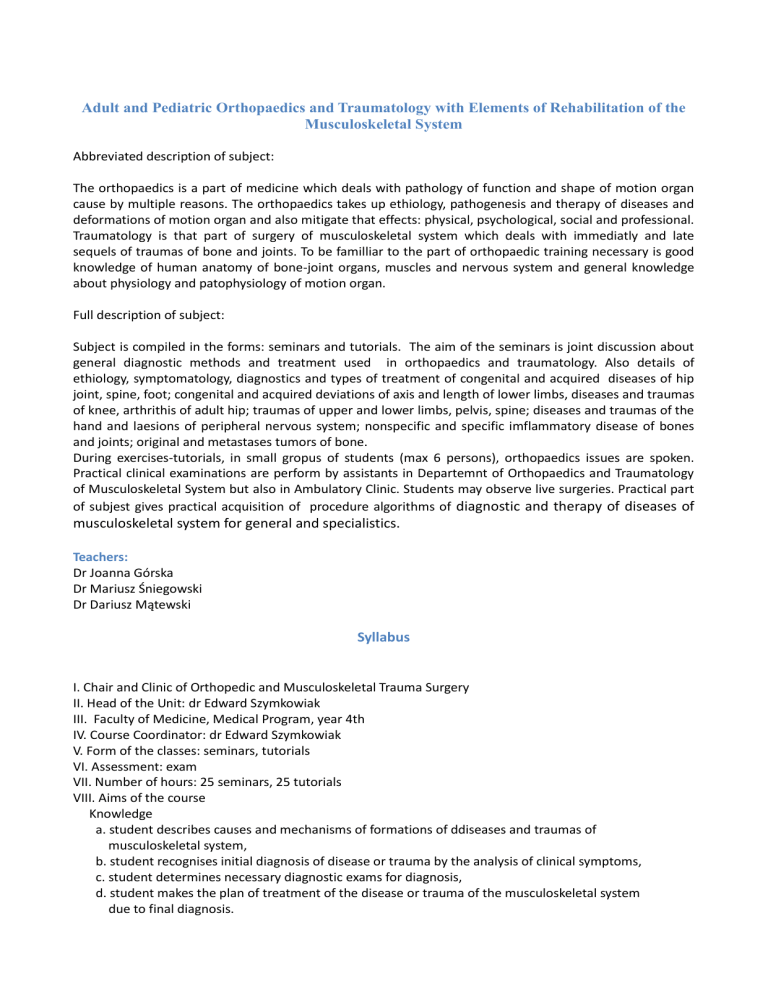
Adult and Pediatric Orthopaedics and Traumatology with Elements of Rehabilitation of the
Musculoskeletal System
Abbreviated description of subject:
The orthopaedics is a part of medicine which deals with pathology of function and shape of motion organ cause by multiple reasons. The orthopaedics takes up ethiology, pathogenesis and therapy of diseases and deformations of motion organ and also mitigate that effects: physical, psychological, social and professional.
Traumatology is that part of surgery of musculoskeletal system which deals with immediatly and late sequels of traumas of bone and joints. To be familliar to the part of orthopaedic training necessary is good knowledge of human anatomy of bone-joint organs, muscles and nervous system and general knowledge about physiology and patophysiology of motion organ.
Full description of subject:
Subject is compiled in the forms: seminars and tutorials. The aim of the seminars is joint discussion about general diagnostic methods and treatment used in orthopaedics and traumatology. Also details of ethiology, symptomatology, diagnostics and types of treatment of congenital and acquired diseases of hip joint, spine, foot; congenital and acquired deviations of axis and length of lower limbs, diseases and traumas of knee, arthrithis of adult hip; traumas of upper and lower limbs, pelvis, spine; diseases and traumas of the hand and laesions of peripheral nervous system; nonspecific and specific imflammatory disease of bones and joints; original and metastases tumors of bone.
During exercises-tutorials, in small gropus of students (max 6 persons), orthopaedics issues are spoken.
Practical clinical examinations are perform by assistants in Departemnt of Orthopaedics and Traumatology of Musculoskeletal System but also in Ambulatory Clinic. Students may observe live surgeries. Practical part of subjest gives practical acquisition of procedure algorithms of
diagnostic and therapy of diseases of musculoskeletal system for general and specialistics.
Teachers:
Dr Joanna Górska
Dr Mariusz Śniegowski
Dr Dariusz Mątewski
Syllabus
I. Chair and Clinic of Orthopedic and Musculoskeletal Trauma Surgery
II. Head of the Unit: dr Edward Szymkowiak
III. Faculty of Medicine, Medical Program, year 4th
IV. Course Coordinator: dr Edward Szymkowiak
V. Form of the classes: seminars, tutorials
VI. Assessment: exam
VII. Number of hours: 25 seminars, 25 tutorials
VIII. Aims of the course
Knowledge
a. student describes causes and mechanisms of formations of ddiseases and traumas of
musculoskeletal system,
b. student recognises initial diagnosis of disease or trauma by the analysis of clinical symptoms,
c. student determines necessary diagnostic exams for diagnosis,
d. student makes the plan of treatment of the disease or trauma of the musculoskeletal system
due to final diagnosis.
Skills
a. conduct clinical examination of the patient,
b. able to make immobilisation of the limb by Kramers splint,
c. practical knowledge of treatment open fractures,
d. able to make plaster cast immobilisation of the fracture,
e. perform haematoma/exudation punction of the knee,
f. able to make skeletal or indirect tracion.
Literature a. general:
1.
Tadeusz Szymon Gaździk "Ortopedia i traumatologia" PZWL Warszawa 1998, 2002, 2005. b. supplementary:
1."Wiktora Degi Ortopedia i Rehabilitacja" pod red. Witolda Marciniaka, Andrzeja Szulca.
Wyd.1, PZWL Warszawa 2003,
2. U.Heim, J.Baltensweiler "Kompendium traumatologii": Kompedia współczesnej medycyny –
pod red. F.Largiader, O.Wicki, A.Sturm PZWL Warszawa 1995
3. "Opatrunki unieruchamiające w ortopedii i traumatologii" pod red. Artura Dziaka PZWL
Warszawa 1995
4. Campbells Operative Orthopaedics by S.Terry Canale and James Beaty. Mosby, Philadelphia
2007.
Rules and regulations
1.
During two weekes before start of orthopaedic seminars student needs to pass initial exam (called
"wejściówka"; colloquy with assistant) testing knowledge of the anatomy of bone, joints, muscles and nervous system of human and general knowledge of patho- and physiology of musculoskeletal system. The initial exam is confirmated by the assistant signature in the individual student cards at the latest in the first day of orthopaedic seminars. Individual students cards should be taken in two weeks before start the orthopaedic seminars. Maximal number of points: 16 points.
2.
Continues rate (preparing to seminars and tutorials and activity): max 4 points.
3.
Practical examination (orthopaedic clinical examination): max 4 points,
4.
Closing exam (colloquy with assistant): max 8 points,
5.
Spoken examination by head of department (conversation with professor) :max 8 points,
6.
Written test orthopaedic exam. Admission to test exam only due to passed closing exam. Max 60 points.
The final subject score:
very good >_90 points
good >_ 78 points
satisfactory >_ 66 points
unsatisfactory < 66 points.
The activity score is infuented by:
preparing the medical history of the patient (at the latest at the day of closin exam)
description of the clinical issue student attitude towards responsibilities during orthopaedic course.
The students which haven't proceeded to the initial exam (during time described in statute) will receive 0 points. The Professor, finally, decides on passing the seminars and tutorials due to conversation with student and reached score during exercises. To pass through exercices with assistant minimal rate is 24 points. For conversation with professor registration at the Secretary of Department of the Orthopaedics and
Traumatology.
MD PhD Edward Szymkowiak
